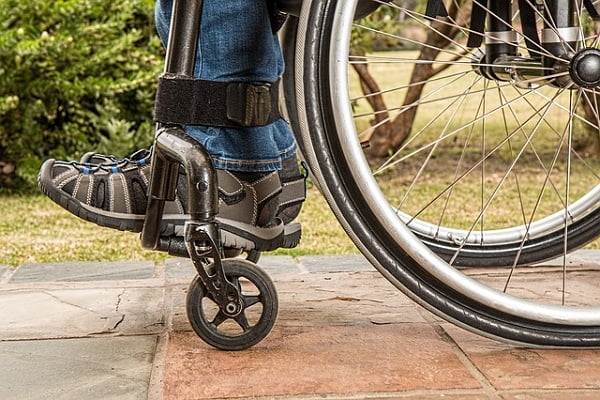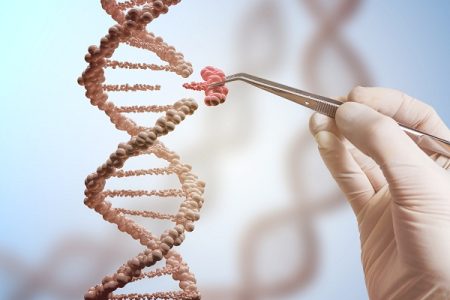
Duchenne muscular dystrophy (DMD) – Definition and Overview
Duchene muscular dystrophy (DMD) is an inherited progressive form of muscular dystrophy. DMD causes muscle degeneration or atrophy (of skeletal and heart muscles) and results in weakness. It occurs exclusively in males and rarely in females. The symptoms of DMD start occurring between 3 and 24 years of age.
History of Duchenne muscular dystrophy
Duchenne muscular dystrophy is named after French neurologist Guillaume Benjamin Amand Duchenne. In the 19th century, after graduating in medicine, Duchenne started his own investigation on muscular dystrophy. He followed his patients from hospital to hospital to complete his research.
Duchenne was the first to perform biopsy by obtaining a small piece of tissue from a living patient for microscopic examination. He inserted biopsy needle in boys who were suspects of DMD and gave an apt conclusion that DMD is a muscular disease.
How is the body affected by muscular dystrophy (DMD)?
Duchenne muscular dystrophy is supposed to be a “muscle-wasting” condition which occurs due to lack of a muscle protein called dystrophin. Dystrophin deficiency causes breakdown of muscle fibres and their replacement with some fatty tissues. This leads to gradual weakening of the muscles. The non-functionality of dystrophin protein or reduction in its amount is a result of gene mutations on the X-chromosomes (X-linked recessive disorder).
Muscle weakness begins at 3 or 4 years of age in the pelvic area, hips or legs, and shoulders. DMD may also result in enlargement of calves (calf muscles). Several heart diseases and respiratory muscle problems begin at teenage and cause serious life-threatening complications.
Duchenne muscular dystrophy causes weakness in the pelvis and upper limbs which results in frequent falling, weakness, loose limbs leading to clumsiness and mild mental retardation in a person. DMD also has an impact on learning and memory, as well as on communication and certain social emotional skills.
How common is it to have Duchenne muscular dystrophy (DMD)? Is Duchenne a rare disease?
DMD is one of the most frequent and rapidly progressing childhood neuromuscular disorders. An estimate suggests that DMD affects every 1 in about 4000 male (live births) throughout the world. Research is going over the gene replacement therapy (with dystrophin minigenes) for the treatment but there is no appropriate cure for DMD.
Current treatment of Duchenne muscular dystrophy, such as assisting with mobility, preventing scoliosis, and providing pulmonary therapy (respiratory toilet), is dependent on its symptoms.
Signs and symptoms of Duchenne muscular dystrophy: Can adults get Duchenne muscular dystrophy?
The symptoms of DMD generally appear just after the birth of a child till 6 years of age. Some common symptoms can be:
- difficulty in walking, running, jumping and climbing the stairs or loss of ability to walk
- fatigue
- rapidly worsening weakness in the legs, pelvis, arms, and neck
- Enlarged calves because the calf muscle cells are replaced by fat and connective tissue (pseudohypertrophy). This may also cause calf pain.
- Memory issues, learning disability or intellect disability occur in about one-third of the affected individuals
- Lack of motor skills development results in taking a comparatively longer time to understand the ability to sit, stand, or walk on own in children. This is also known as delayed motor development.
- Difficulty in getting up from the floor (Gower maneuver).
- Muscle weakness primarily affects hips, thighs and shoulders, pelvic area and then proceeds to the skeletal muscles in the arms, legs and trunk.
- Contractures (tight or rigid joints) can sometimes develop when muscle-loss progresses. It affects the knees, hips, feet, wrists, fingers, etc. Ignoring this might cause some severe problems such as discomfort and restriction mobility and flexibility.
- Respiratory or breathing problems occur due to weakness of the diaphragm and other muscles around the lungs.
- Scoliosis or other skeletal problems might also result in breathing difficulty.
- Heart problems such as progressive enlargement, thickening and stiffness of the heart (cardiomyopathy) can be a serious threat to life. In cardiomyopathy, the heart muscles restrict the mechanism of pumping of blood efficiently leading to chest pain, fatigue or breathlessness.
- Social behavior is affected and communication becomes more difficult in some cases.
Causes of Duchenne muscular dystrophy (DMD)
DMD is a genetic disorder which is mainly caused by gene mutation. The mutation in the genetic code occurs in dystrophin, located on the X chromosome or sex-chromosome. Dystrophin is a protein that is associated with DMD.
The function of dystrophin is that the cytoskeleton of every single muscle fiber gets linked to the underlying basal lamina (extracellular matrix) with the help of a protein complex with multiple subunits. Lack of dystrophin causes rapid muscular deterioration. It results in muscle cells to become fragile that get easily damaged.
DMD ‘carriers’
In females, one X-chromosome carries a normal dystrophin gene while the other X chromosome carries an abnormal dystrophin gene. They are known as DMD carriers.
In a DNA, girls have two X chromosomes and boys have only one X chromosome. DMD has an X-linked recessive inheritance pattern and the mutated gene is located on the short arm of the X chromosome. Typically, females are carriers of the genetic traits and males are affected. A female carrier is unaware of the mutation within her own genes until and unless her son gets affected by it. In most cases, the cause of DMD is inheritance from the mother who is the ‘carrier’, but DMD can also be caused by new mutations in the genes of a child.
The abnormal gene results in lack of dystrophin protein. Usually, females are not affected with DMD because a second X-chromosome is also present in them which can produce a dystrophin protein. Therefore, a very small number of female carriers suffer from muscular weakness and are known as ‘manifesting carriers’.
Diagnosis of Duchene muscular dystrophy
The diagnosis of Duchene muscular dystrophy is done after symptoms start appearing in a person or if there is some family history.
Physical examination
If muscular pain or weakness starts appearing in a child, wellness exams are conducted to look for specific signs of muscular dystrophy.
The first and foremost symptoms of Duchenne muscular dystrophy, in general, appear between the ages of one and three years. The child might suffer with problems related to muscle function which affects the physical abilities of the child such as walking, running, jumping, standing, etc. Their calves might enlarge. Family history is very important in the diagnosis process.
Blood tests for DMD
Blood tests and muscle biopsies confirm the diagnosis of DMD.
Creatine phosphokinase test
A large amount of creatine phosphokinase enzyme is released (or leaked) into the blood as the muscles deteriorate. This increased level of creatine phosphokinase signifies muscle weakness and damage leading to DMD. For confirmation, this enzyme test is followed by muscle biopsies or genetic tests which help determine the type of muscular dystrophy.
Most of the times, with the creatine phosphokinase (CPK or CK) test, some liver enzymes (aminotransferases, ALT- alanine transaminase and AST- aspartate transaminase) are also found to be high, and are also checked to diagnose and confirm the DMD.
Molecular genetic testing
Molecular genetic testing is used to detect any change or mutation in the dystrophin genes by analyzing the DNA of the blood cells. This mutation results in DMD or sometimes dystrophinopathies (a related muscular dystrophy, MD).
Genetic counseling and testing is very important and is done to look for the inheritance factor from other family members. Genetic testing is also done to check if there is a possibility that any other family member might also be at risk of getting the DMD disease.
Muscle biopsy
Muscle biopsy is a process in which a small sample of muscle is surgically taken or removed for analysis. The amount of dystrophin protein present in the muscle cells helps to diagnose DMD. Due to better, cheaper and accurate results obtained through genetic testing, muscle biopsy is rarely used in the diagnosis of DMD.
Treatment of Duchenne muscular dystrophy (DMD)
Although, there is no known cure for Duchenne muscular dystrophy (DMD) but there are on-going clinical trials to look for exact treatment methodology. During the treatment, electromyography can be used to differentiate specifically the conditions that have an impact on the muscles only.
The main aim of treating DMD is to decrease the severity of disease and its related complications such as progressive muscle weakness, minor disabilities in learning, talking, etc and loss of quality of life. The best treatment options for DMD are described below:
Use of steroids for DMD
- Steroids (corticosteroids) are used as they improve the strength and function of muscles in patients suffering with DMD.
- Prednisone is a kind of steroid. The use of predinisone extends the ability of walking by 2 to 5 years longer. There are certain side effects of prednisone such as weight gain, high blood pressure, behavior changes, and delayed growth.
- Deflazacort is a form of prednisone more prevalently used in Europe and is also approved by FDA in the United States. Compared to predinisone, it is supposed to have fewer side effects.
- Oxandrolone (Oxandrin and Anavar) is an androgen and anabolic steroid (AAS) used to promote weight gain or muscle gain and it has fewer side effects compared to prednisone.
The U.S. – FDA (Food and Drug Administration of United States) approved treatments
Eteplirsen
The use of Eteplirsen (Exondys 51- manufacture by Sarepta Therapeutics, Inc.) has been approved by FDA to treat DMD.
The DMD gene has 79 exons (codes for proteins). An injection of eteplirsen treats mutations of the dystrophin gene. A confirmed mutation in the DMD gene is open to exon 51 skipping when treated with Eteplirsen. DMD gene allows a shortened form of dystrophin to be made if exon 51 is skipped.
About 13% of those with DMD may be helped by Exondys 51.
The most common side effects of this injection are balancing problems and vomiting. The drug is supposed to increase the production of dystrophin protein to enhance proper functioning of the muscle.
Deflazacort
The Deflazacort (Emflaza- Marathon Pharmaceuticals) is a corticosteroid given orally to retain muscle strength and treat DMD. In 2017, Deflazacort became the first corticosteroid to get the FDA approval to treat DMD.
Some common side effects of deflazacort are puffiness, increased appetite and weight gain.
Other treatments for DMD may include:
- The use of Albuterol (a drug used for asthma patients), amino acids, carnitine coenzyme Q10, Fish oil, Green tea extracts, etc can provide strength to the muscles.
- Translarna (ataluren) is another drug available in some European countries which lowers the progression of symptoms in boys with Duchenne muscular dystrophy. The drug works for boys who suffer with a specific mutation in the dystrophin gene said to be ’nonsense’ mutation. In this, a single letter change in the DNA code results in a premature stop codon.
- Assisted ventilation is provided for an increased life span when lung function begins to deteriorate in the late stages of the disease.
- For better functioning of the heart, pace maker can be used with some other drugs, such as diuretics, angiotensin converting enzyme inhibitors, beta blockers, etc.
- Early treatments of cold and chest infections are necessary as the lung functioning gradually deteriorates when respiratory muscles weaken.
- Physical exercises and orthopedic appliances (such as braces and wheelchairs) are recommended to improve mobility which reduces any contractures and deformity.
Prevention and prognosis of Duchenne muscular dystrophy: Can you prevent Duchenne muscular dystrophy?
Preventing DMD is not an option as it is genetic and passes from the mother to the child. Genetic testing can only verify that whether or not there is an increased risk of the occurrence of DMD due to mutations.
The progression of muscle weakness results in increasingly difficult complications such as cardiomyopathy, deformities, mental impairment, etc. The condition was earlier supposed to be quite severe as it significantly shortens the life-expectancy. However, high standards of researches and treatments have achieved a goal that most young men suffering with Duchenne muscular dystrophy reach adulthood. Death might occur due to progressively worsening disability typically from heart problems and lung disorders at an approximate age of 25.
In extremely rare cases, patients of DMD survive into their forties or early fifties, with great care and specificities such as proper positioning in wheelchairs and beds, and the use of ventilator support for respiration, heart medications, etc.






